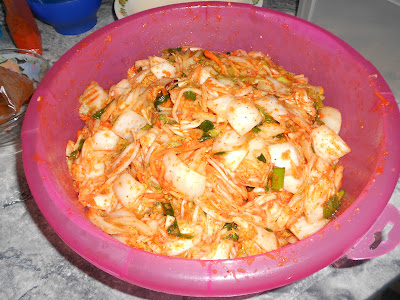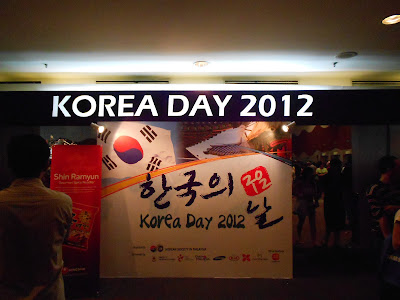After so many request from my friends and my followers to show the recipe on how to make Kimchi, finally I decided to post it here.
Kimchi (Korean: 김치), also spelled gimchi, kimchee, or kim chee, is a traditional fermented Korean dish made of vegetables with a variety of seasonings. It is Korea's national dish, and there are hundreds of varieties made with a main vegetable ingredient such as napa cabbage, radish, scallion, or cucumber. Kimchi is also a main ingredient for many Korean dishes such as kimchi stew (김치찌개; kimchi jjigae), kimchi soup (김칫국; kimchiguk), and kimchi fried rice (김치볶음밥; kimchi bokkeumbap).
Let me show you how to salting the cabbage.
First, prepare about 3 large Chinese cabbage (Napa cabbage) like this (it's up to you how much you want to make but for me, I use 3);
Then cut it into 4 part like this and don't forget to wash it twice;
I want to make into bite pieces so, I'll cut 1 part of the cabbage into half like this;
And cut again into small pieces like this;
Prepare the salt and when use it, put the water in the bowl;
 |
| I use this much salt for 1 1/2 of the cabbage |
 |
| This portion is about 1 1/2 of cabbage |
The cabbage will look like this after 3 hours;
Wash it twice and drain it after that;
Now time to prepare the chilli paste. The ingredients that we need for the paste are;
Ingredient A
1 Big Onion (Holland onion)
10 Cloves Garlic
1 Inch Ginger
1/2 cup Fish Sauce
Ingredient B
1/2 cup Glutinous Rice Flour
1/2 cup Sugar
1 1/2 cup Water
1/2 or 1 cup Chilli Powder
For other vegetable in the paste;
1 Carrot
1/4 Radish
Spring Onion (Put in according to your taste. If you like more spring onion, then put many)
First, blend together all of Ingredient A until it become like this and put it in the big bowl;
After that, prepare the Ingredient B because it need to be cook like this;
 |
| Stir continuously the ingredients with low heat |
 |
| Until it become thick like this |
Let's make the chilli paste!!!
Put together Ingredient A, Ingredient B and Chilli powder in one big bowl like this;
 |
| Chilli powder that I bought from Korean market |
Mix it together until it become like this;
Let's put the carrot, radish and spring onion one by one like this and mix it together;
Put the soaked cabbage that we already wash earlier in to the bowl and mix it together. Please use hand gloves or plastic to avoid the chilli paste from the hands.
Prepare a container to put the Kimchi. (I use this container to put all my Kimchi)
I eat some before put it in the fridge because it looks so delicious and trust me you won't regret it!!!
Good luck and let me know if you want to know anything regarding this recipe~
Till my next post, Annyeong!!!
















.jpg)



























 Chuseok (Hangawi)
Chuseok (Hangawi) Charye (ancestor memorial services)
Charye (ancestor memorial services) Beolcho (clearing the weeds around the grave) and Seongmyo (visiting ancestral graves)
Beolcho (clearing the weeds around the grave) and Seongmyo (visiting ancestral graves) Ssireum (Korean wrestling)
Ssireum (Korean wrestling) Ganggangsullae (Korean circle dance)
Ganggangsullae (Korean circle dance)  Chuseokbim (Chuseok dress)
Chuseokbim (Chuseok dress) Songpyeon
Songpyeon Liquors
Liquors